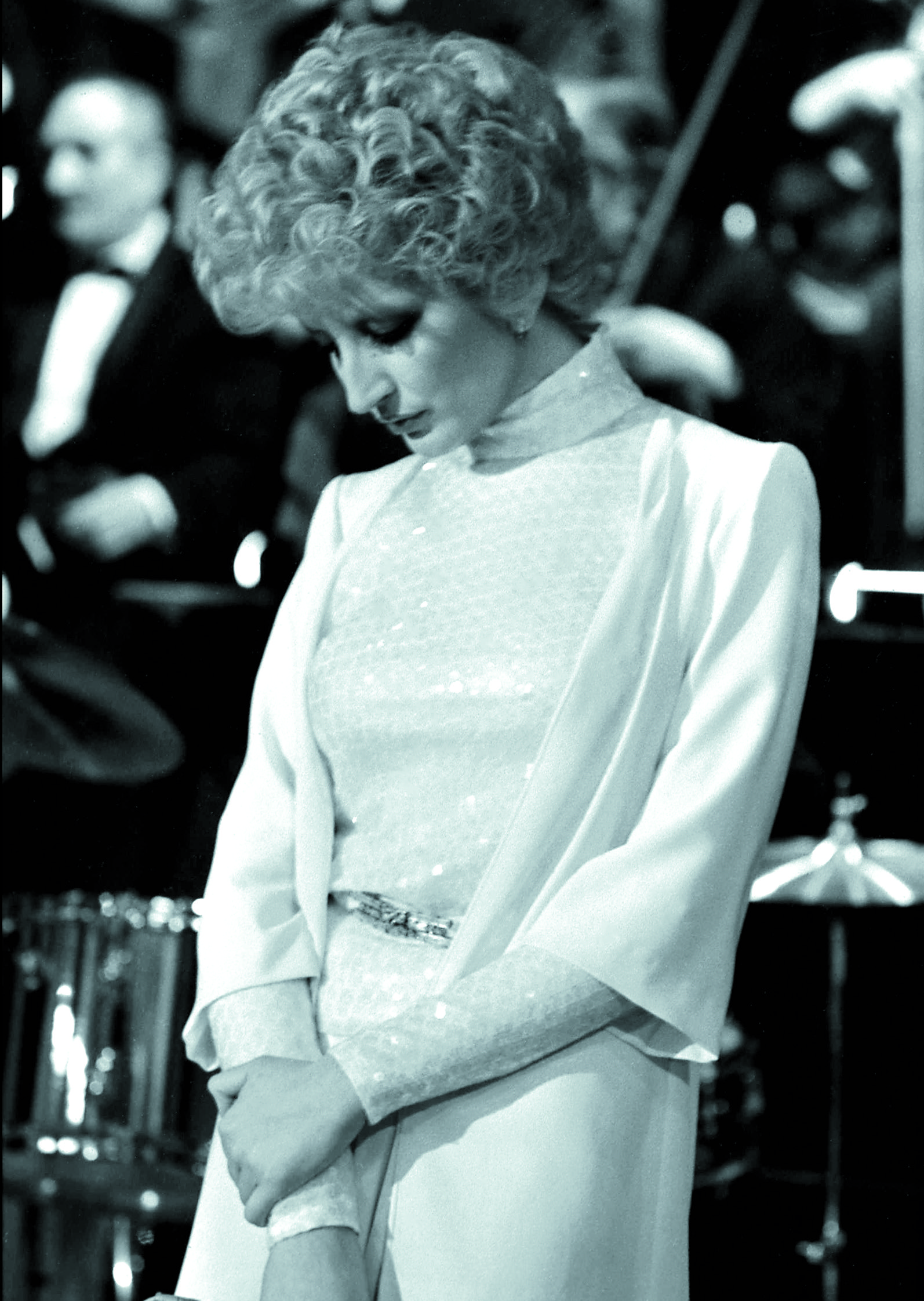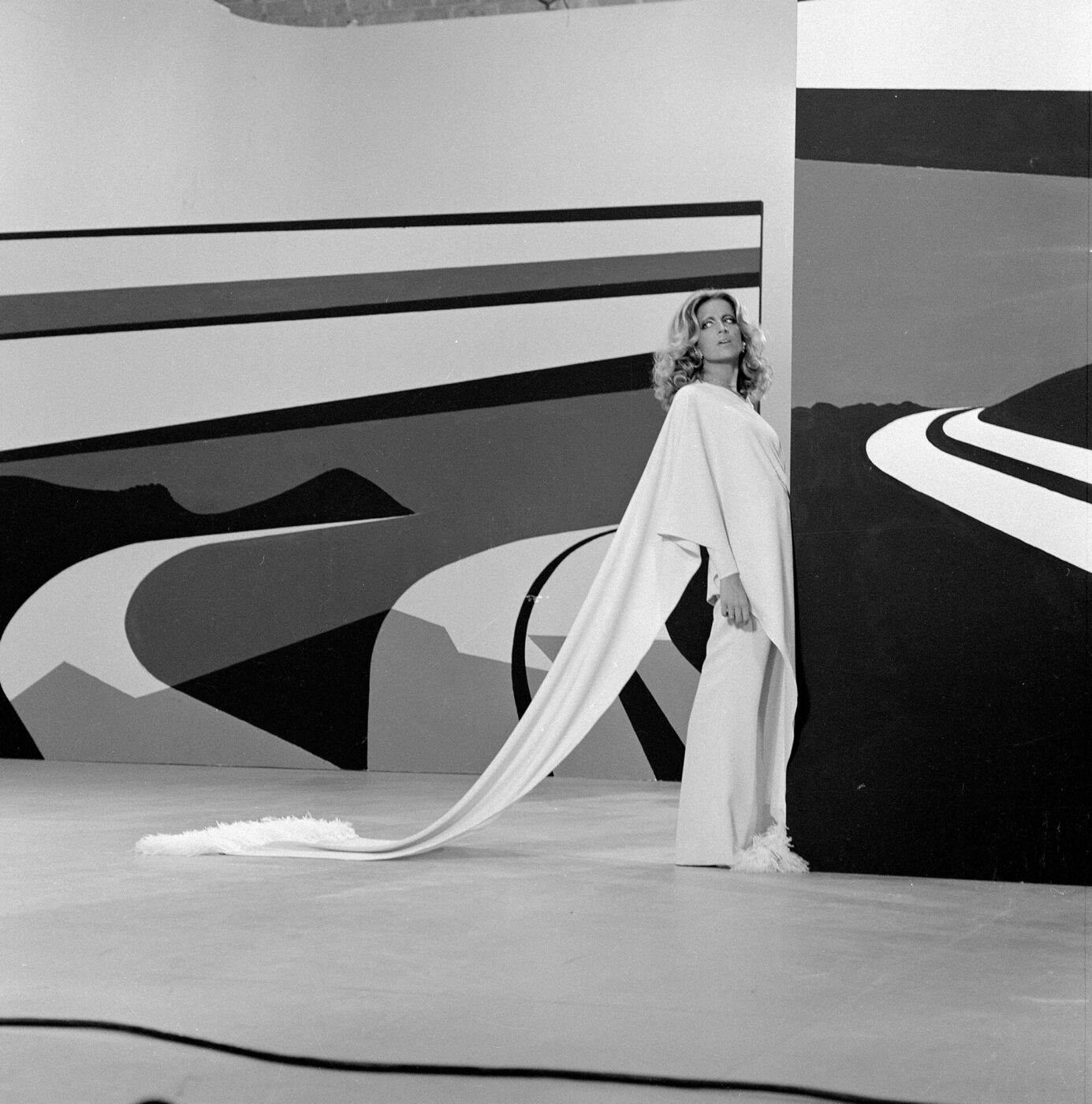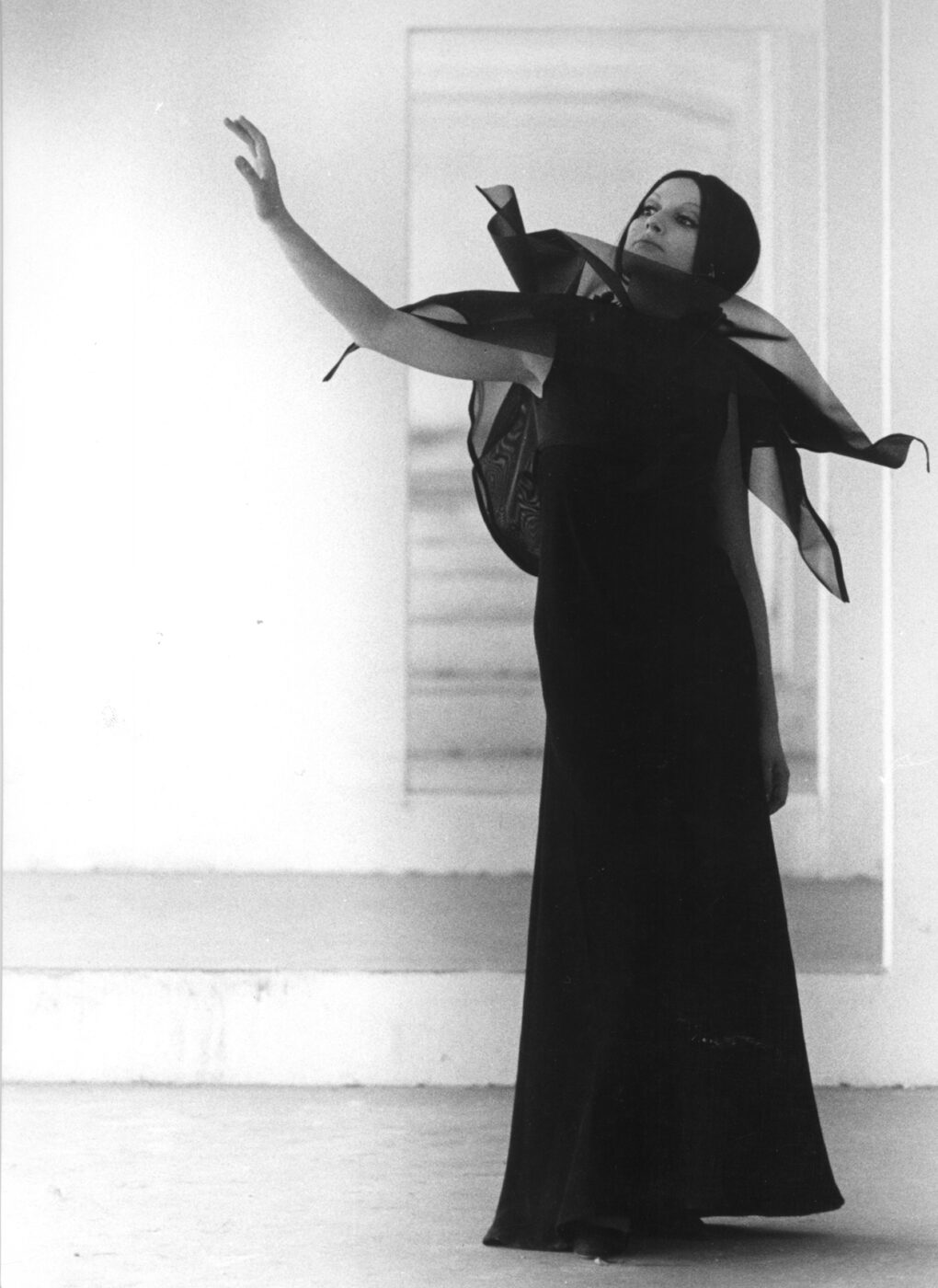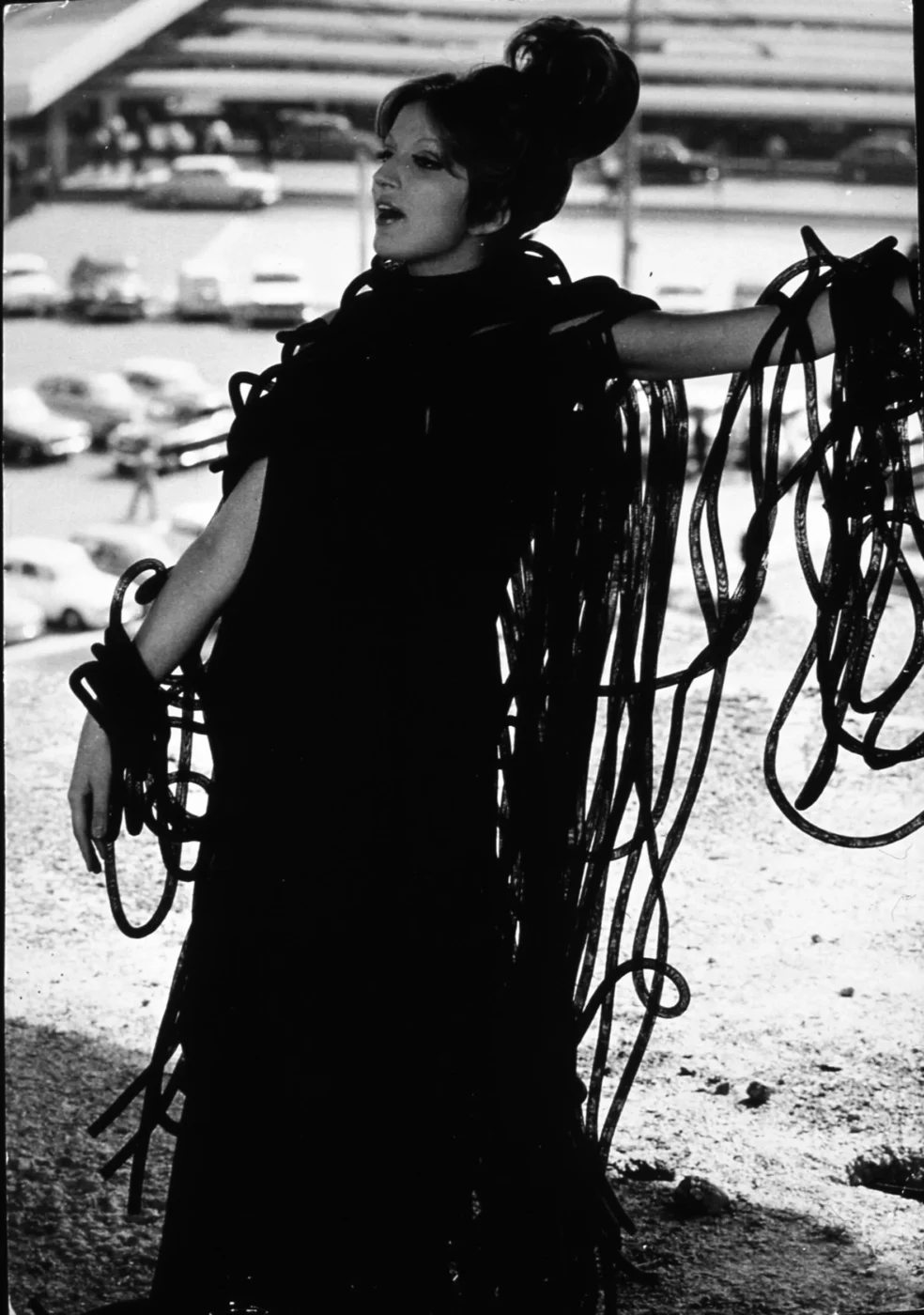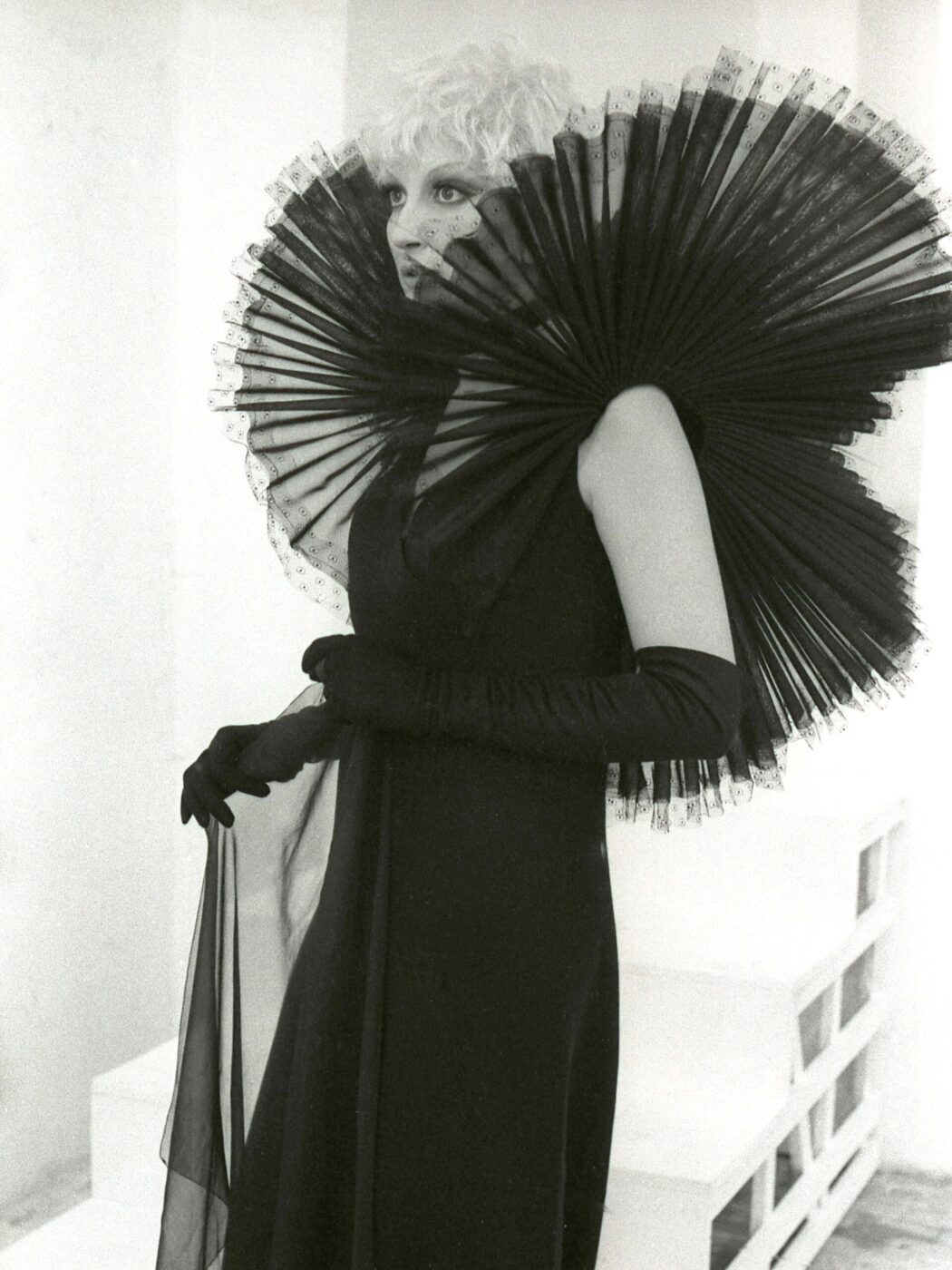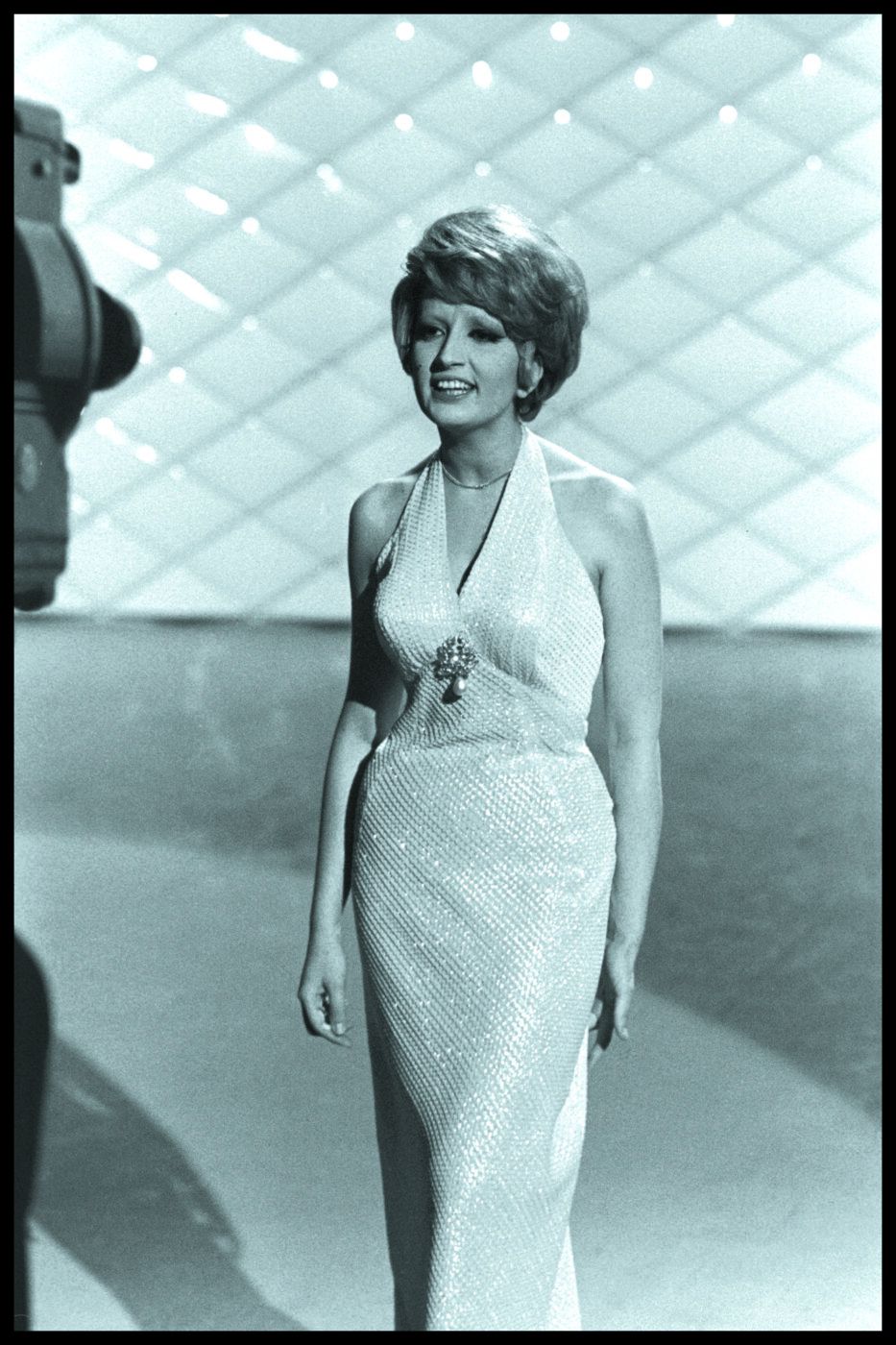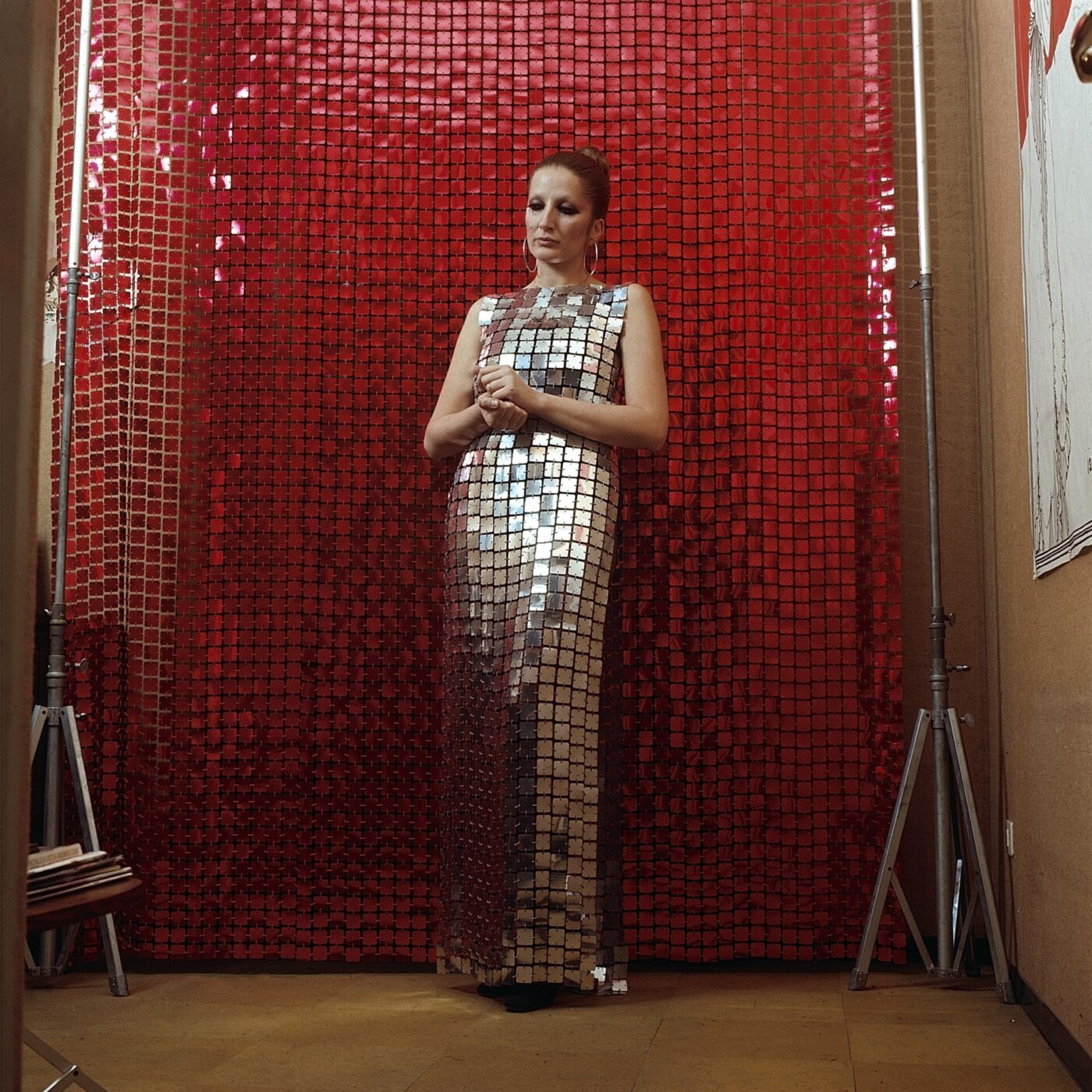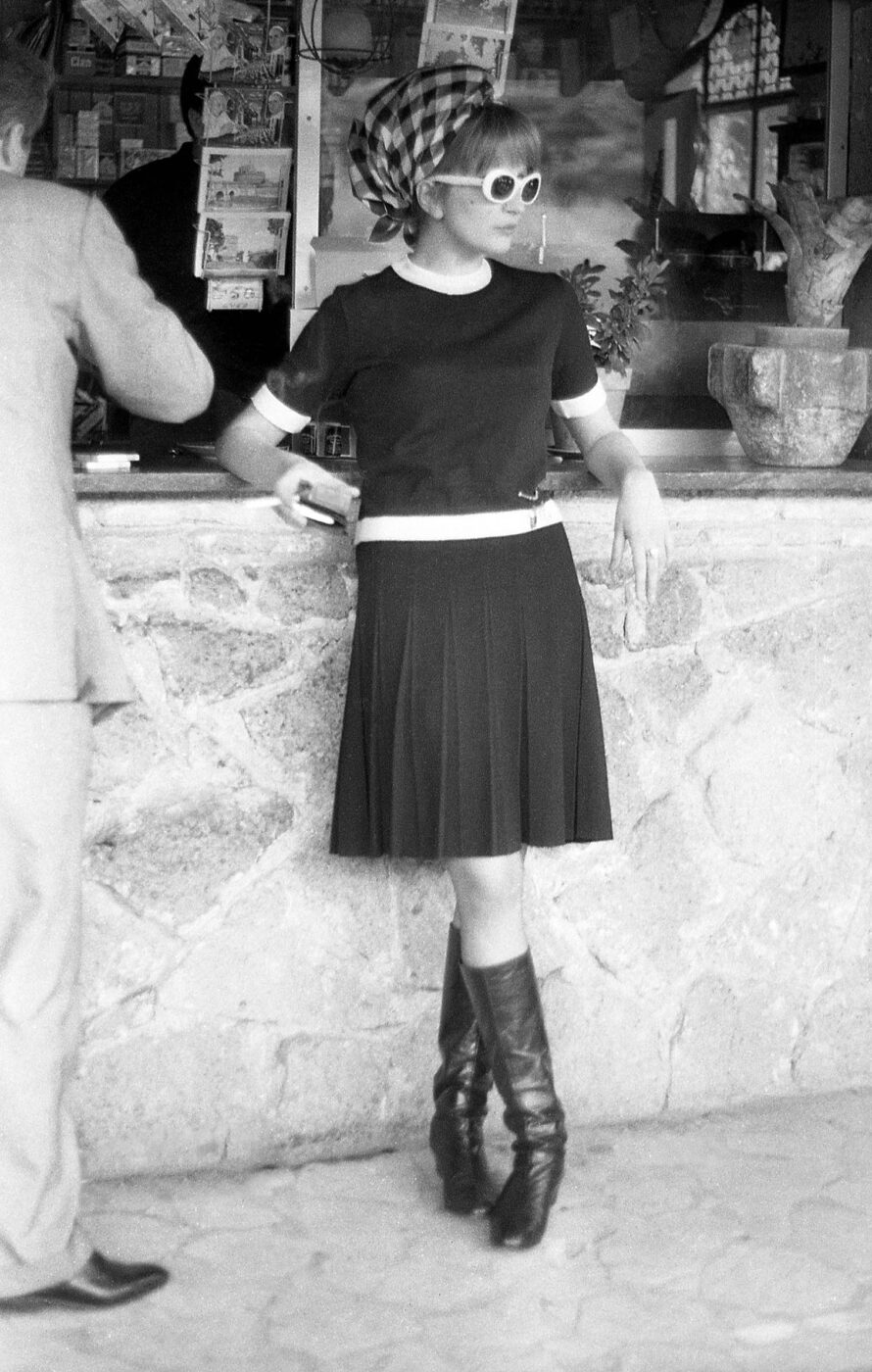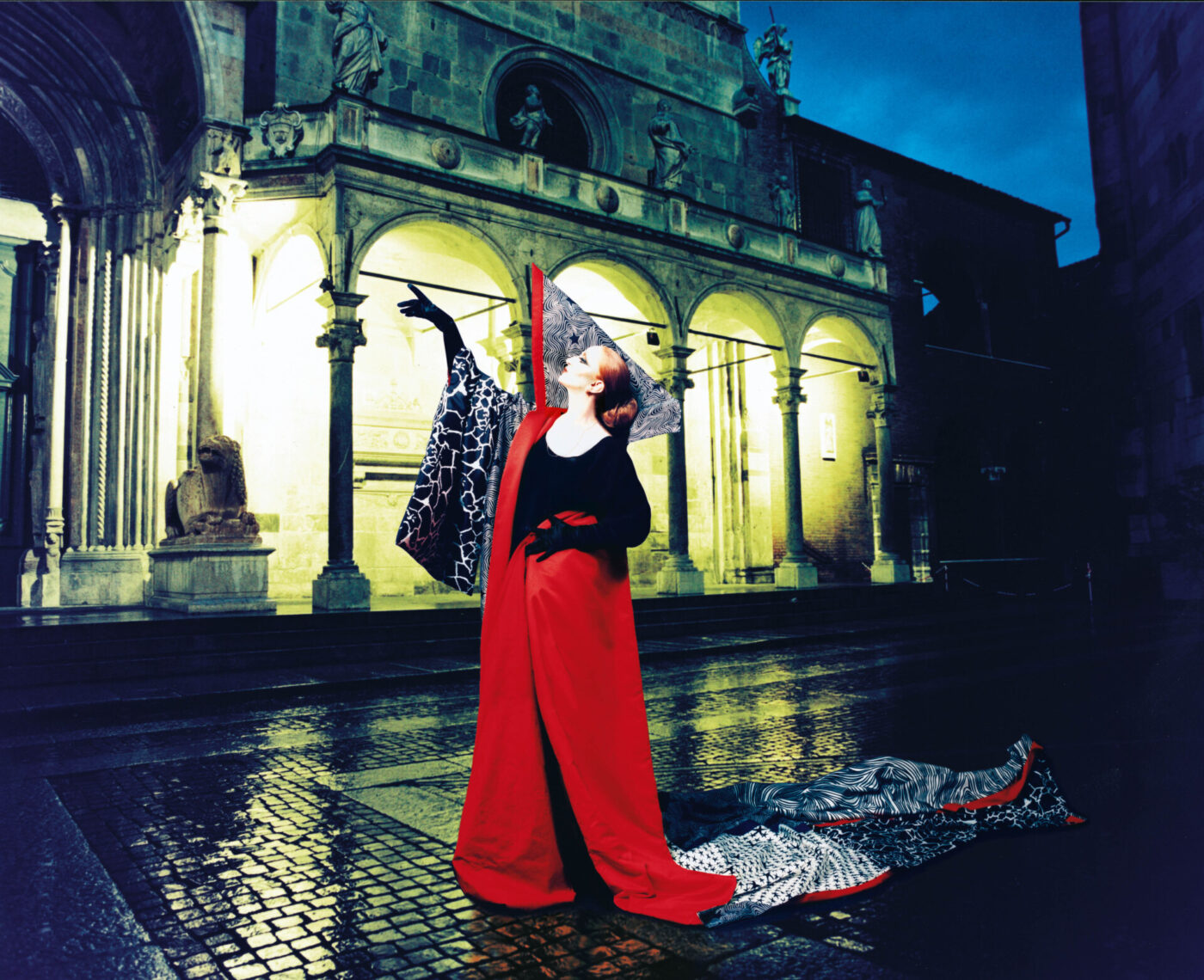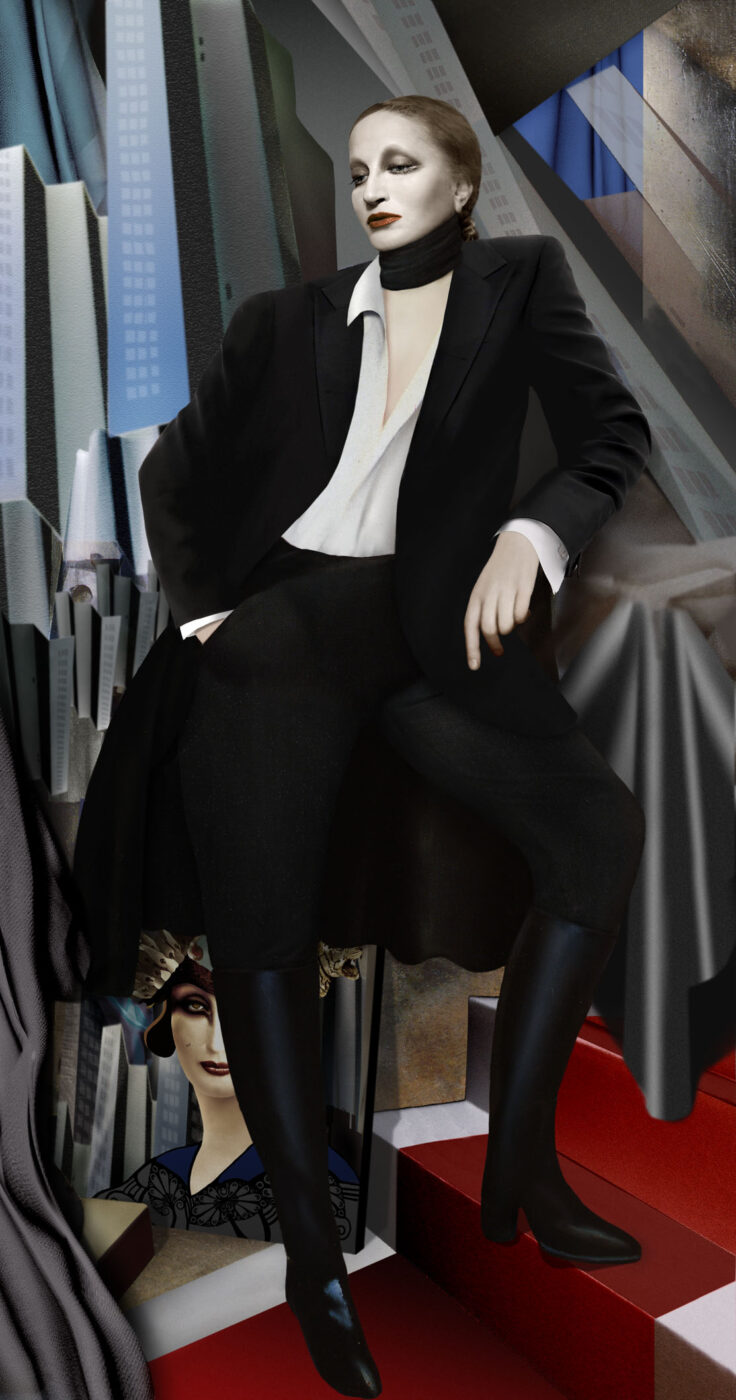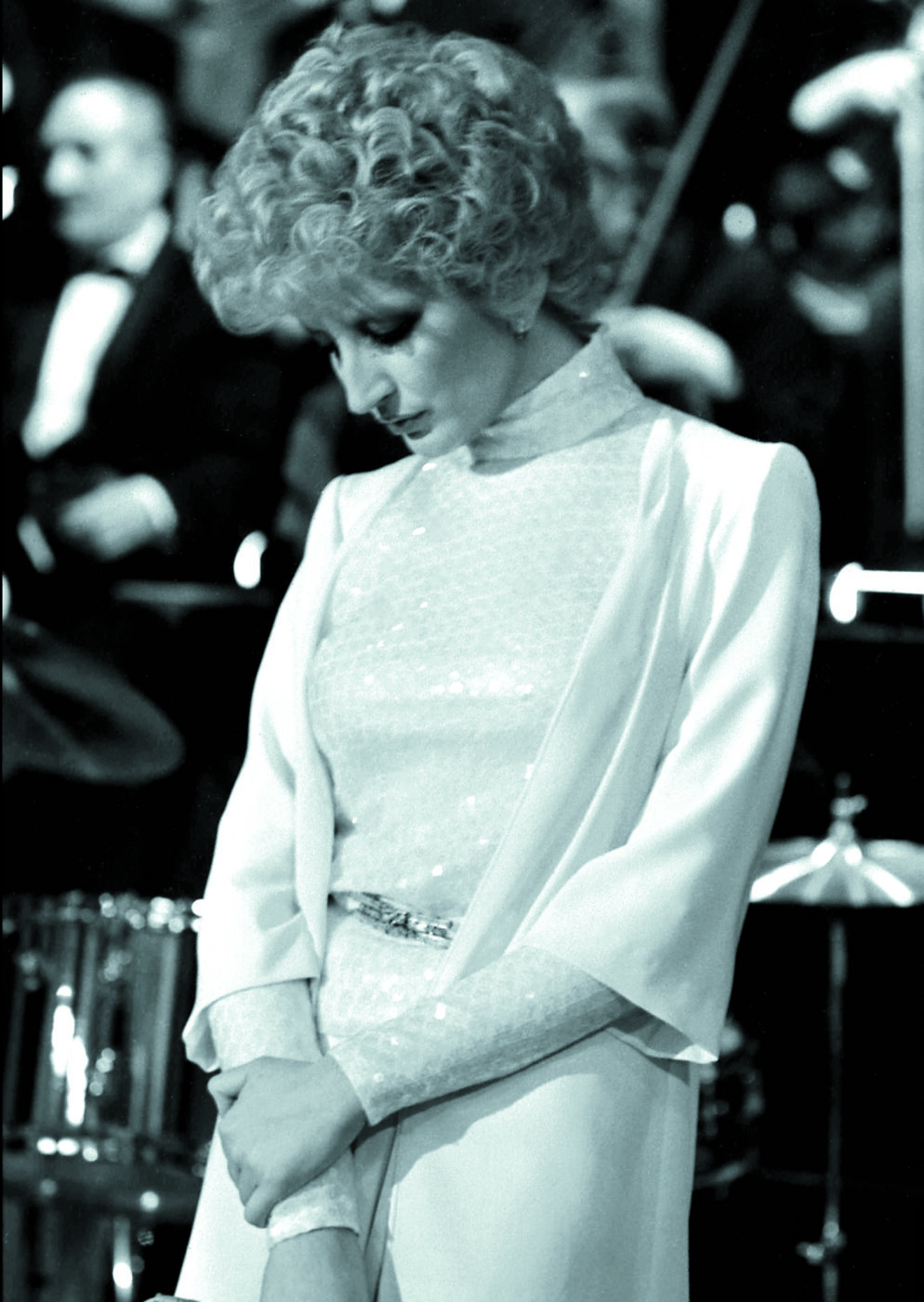“The more I look at her the less I understand who she is,” Italian journalist Orianna Fallaci wrote about Mina in 1961. According to Fallaci, Mina was the “myth of Italians young and old, poor and rich, suckers and smart, communists and Catholics.” This statement suggests the star’s chameleon-like ability–uncanny at times–to transform from the “girl next door” to the glamorous diva italiana to the devilish seductress by Saturday night.
Always meticulously orchestrated, the singer’s outfits were the foundation of her every metamorphosis, though, interestingly, it can often be somewhat of a mystery as to who designed and created them for her. In a fashion context (although the word “fashion” is used reluctantly to describe the star’s relationship to her outfits), “Mina” meant artistic expression, “Mina” meant empowerment, and “Mina” meant ultimate escapism. She beguiled us with every outfit she wore, and therefore, with every “character” she evoked while wearing it. As Fallaci mused, it’s difficult to comprehend the multitudes of Mina expressed through the star’s outfits over the decades. From sculptural avant-garde gowns to her famous furs, here are 10 of the star’s most legendary fashion moments.
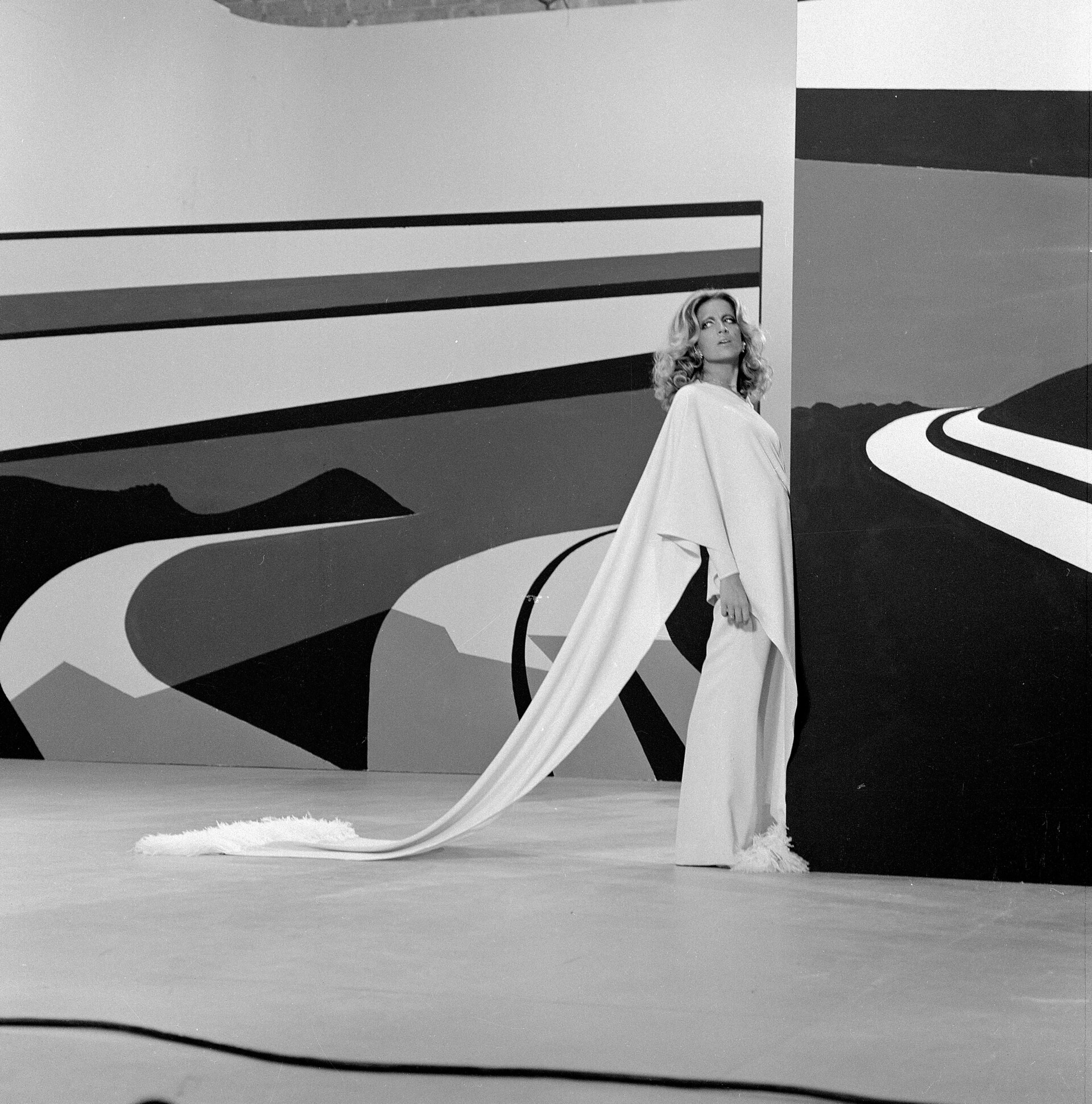
Mina in a Barilla commerical; photo by Roberto Bertolini ©PDU
The girl next door: Festival di Sanremo (1961)
It’s Sanremo, 1961. A 21-year old Mina takes to the Ariston Theatre stage in a charming white organza frock with a collar, cinched waist, and a “corolla”-style skirt splashed with blue polka dots. Che figura! Line director and freelance fashion curator Stefano Salvitici, who knows the provenance of many a spot or sequin Mina wore throughout her career, confirms this dress was created for the singer by trusted dressmaker Rosetta Gussoni Reclari, as were all the outfits Mina wore on this occasion. This dress captured the essence of Italy’s “Dolce Vita” dream that had begun to infatuate the world by the early ‘60s–the epitome of a “sartorial chic” feminine style we associate with Italy at the time. Playful and oh-so Mina, the garment’s spots also reference the song she performed at Sanremo, “Le mille bolle blu” (“The thousand blue bubbles”). The dress, therefore, was part of her performance, emphasizing the song’s upbeat spirit and musicality. Many of Mina’s stage outfits throughout her career would play a similar role in enhancing the mood and themes of the songs she performed.
“At moments her pretty face is innocent and I feel as if I love her like a little sister who has to defend herself because she cannot tell lies…,” Fallaci wrote about Mina in the same article published in The European. This outfit is the “little sister.” It recalls the character of a woman who kept a blue nylon teddy bear by her side to fall asleep every night, as anecdotes about the star have suggested:
“At night, Mina doesn’t sleep unless she has her teddy bear between the sheets, and as outlandish as it may seem in a 20-year-old who has been given thirty-three boyfriends and sings love songs as if she knows what she is saying, the news is accurate: even the waiter who brings her coffee in the morning confirms it,” Fallaci wrote.
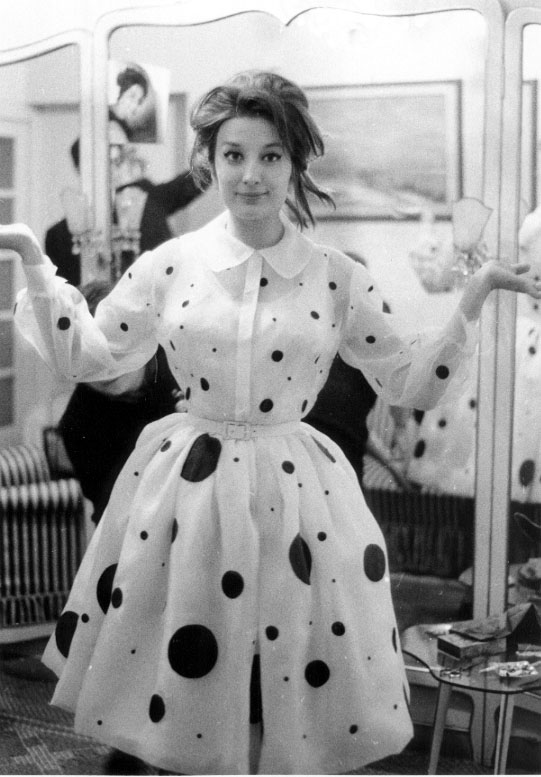
1961 Festival di Sanremo, at which Mina sang "Le bolle blu"; ©Publifoto/Olycom
The sculpture-wearing seductress: “Taratatà” (Barilla, 1966)
At the other extreme, we have Mina the enigmatic seductress dressed in black. The singer ignited the fantasies of Italians all over the country when she appeared in a series of commercials for the Italian pasta brand Barilla in the mid-60s. Directed by creative maestro and Fellini collaborator Piero Gherardi, these commercials (which aired on the popular TV advertising program Carosello) fueled the “Mina Phenomenon” through a hypnotic mix of her hit songs, unexpected sets, and a collection of Gherardi-designed outfits that stamped themselves in the Italian fashion history books.
Gherardi’s genius convention for dressing the star in these videos started with a simple black shift dress, upon which he layered gravity-defying fabric features to give each look a formidable character. In the “Taratatà” video, Mina appears in a floor length column-style shift dress with wired organza sleeves and neckline details that protrude sharply from her decolletage. Her bonnet-style headpiece gives the outfit an air of both pious modesty and decadent grandeur. Mina resembles a forbidden rose. Fallaci’s words resonate again: “…at moments her pretty face is devilish and I feel as if I am being led around by the nose by the shrewdest woman I have ever dealt with.”
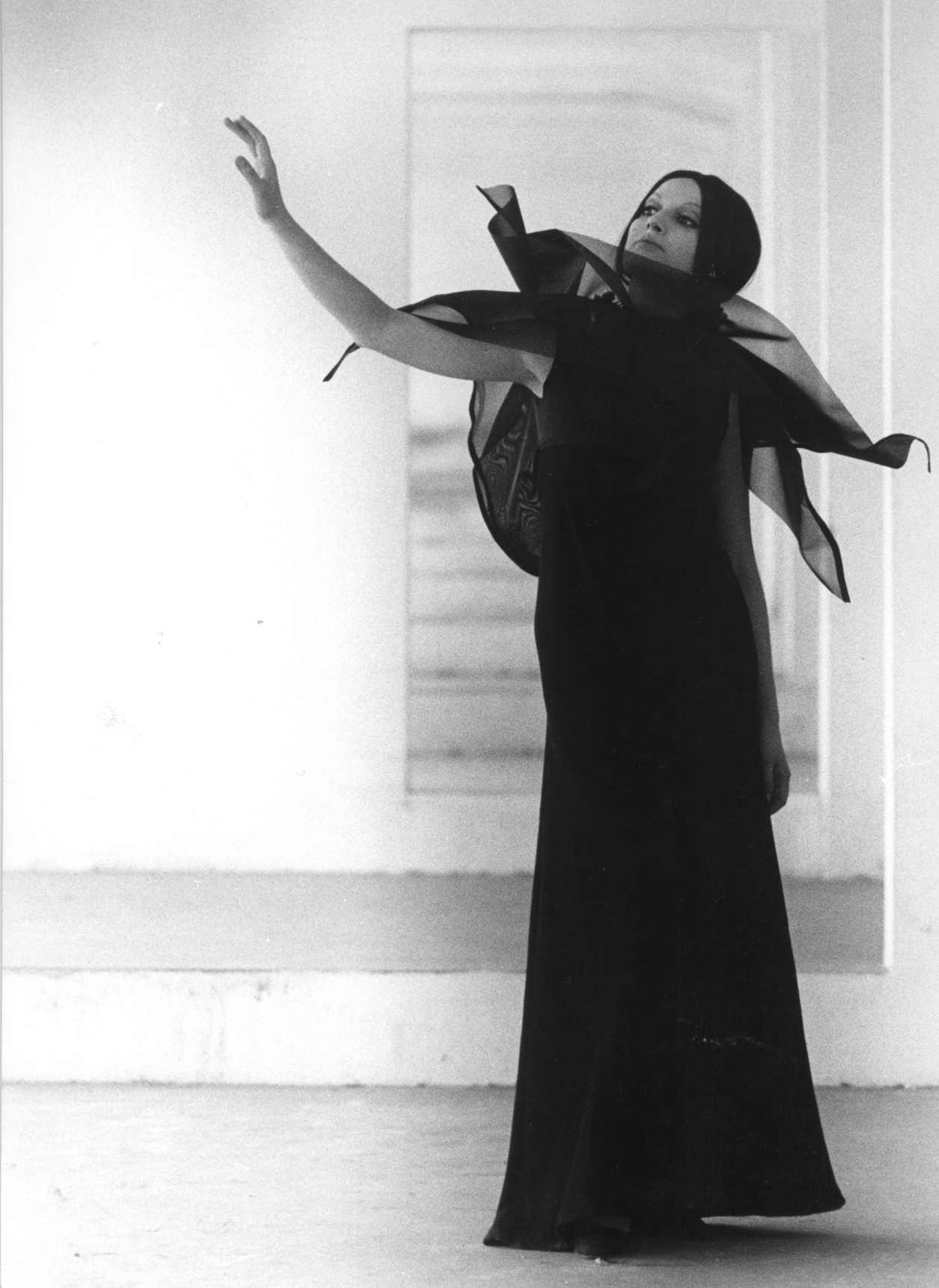
Mina performing “Taratatà” for Barilla; photo by Piero Gherardi
An artist in motion: “Se telefonando” (Barilla, 1966)
The outfits Gherardi designed for Mina were as much social statements as they were feats of wearable art. Pushing silhouettes and proportions to avant-garde extremes, his designs reject the feminine Dolce Vita glamor many people expected from the star in her role as Barilla’s brand ambassador. Rather, they are bold statements of empowerment and freedom of expression–inspiring the idea that Mina (and therefore women) could captivate the world without wearing diamonds or designer couture.
In the Barilla clip for “Se telefonando”, the singer saunters around on the roof of Naples Train Station like a modern Medusa, wearing a long black dress and tangles of tubular strands (perhaps telephone cords!) that wrap her body from head to toe. Mina, being Mina, wears this near-impossible outfit as though it were a second skin. She is the enigma we want to understand, to become familiar with, but can’t quite figure out.
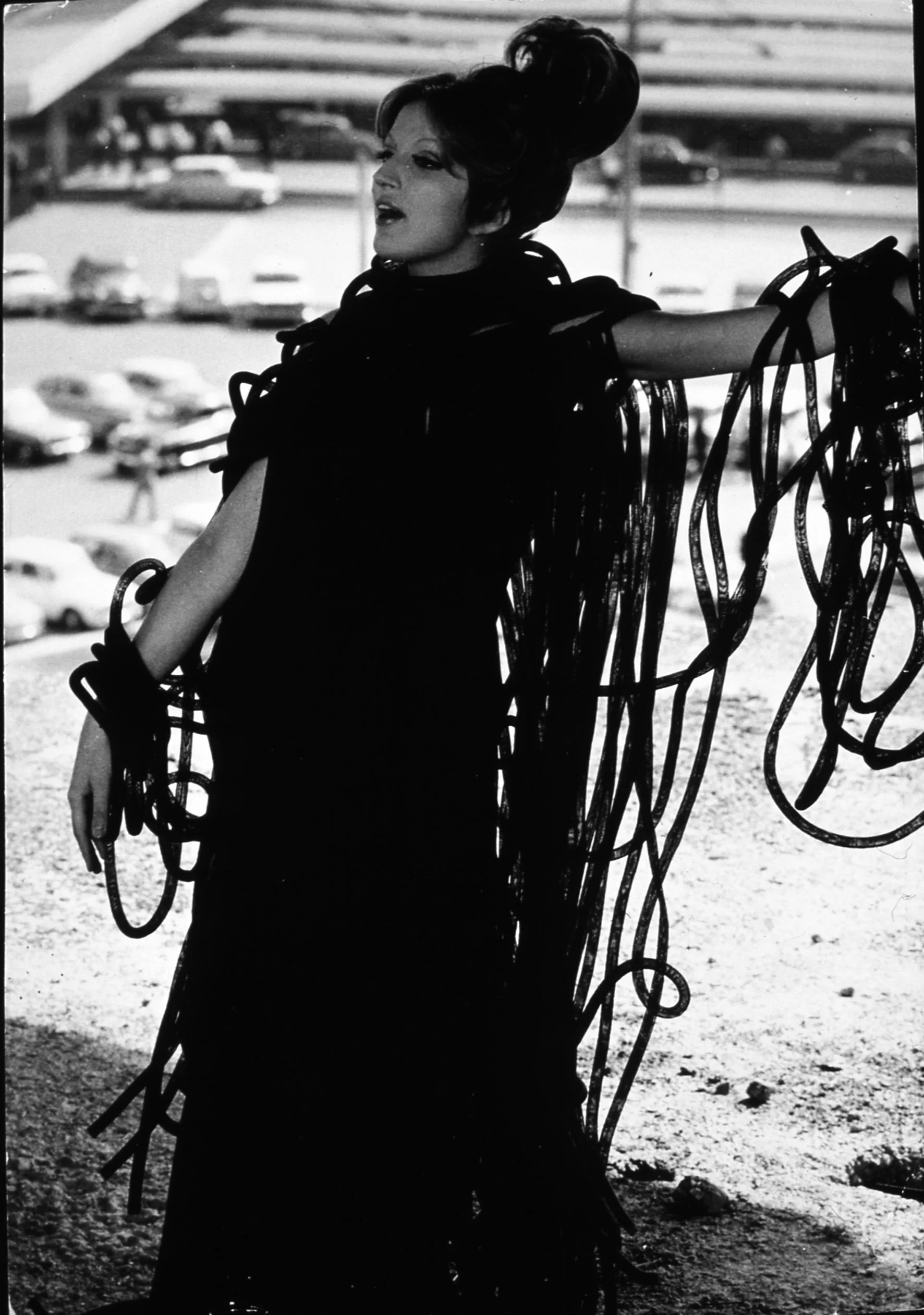
Mina performing "Se Telefonando" for Barilla; photo by Piero Gherardi
Symbolic silhouettes: “Non illuderti” (Barilla, 1966)
Gherardi also designed Mina’s Barilla campaign outfits not just as costumes, but as part of her performances’ narratives. Each diaphanous silhouette reflected the mood and themes of the hit songs she performed in these videos, bringing her music to life in an artistic new dimension. With giant shoulder features like two reptilian appendages, Mina’s outfit for “Non illuderti” (“Don’t fool yourself”) enabled the singer to play a coyish game with the camera, revealing and concealing her face behind these sculptural “shadows”. Mina is like an exotic bird who has descended into a surreal industrial setting, and yet, she moves around the space as though it were her living room.
“Don’t fool yourself / You mustn’t fool yourself / I don’t know how to pretend / I don’t want to pretend / Don’t waste your tears,” Mina sings. The irony is, of course, that the singer’s dress is itself a vehicle of deception. One can only speculate about what deep, dark secrets are hiding behind those sleeves.
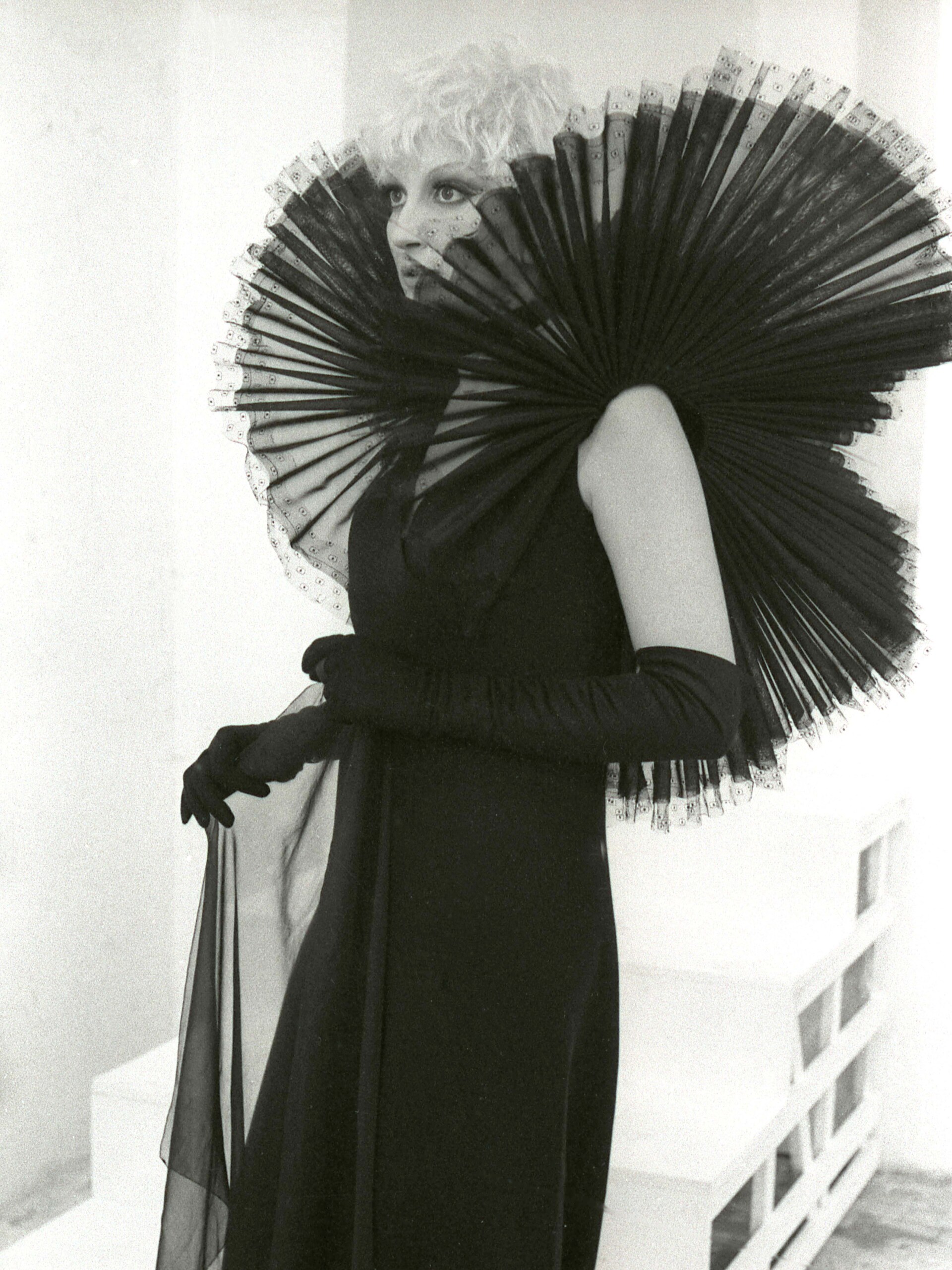
Mina performing “Non illuderti” for Barilla; photo by Piero Gherardi
La Mina’s eternal glamor: Studio Uno 66 (1966)
Signore e signori, La Mina! A vision in a white halter-neck sequined gown that hugged her hourglass figure, Mina dazzled while performing songs from her album Studio Uno 66 with a live orchestra. This dress, designed by Italian fashion designer Fausto Sarli, is one of the most timeless and quintessential looks we associate with a prima diva italiana of the 60s, and few others could wear it quite like Mina. Despite its dazzling sequins and jeweled bust feature, the gown doesn’t overshadow Mina’s natural radiance, nor does it appear extravagantly over the top. It was a gown fit for a star who was “the first real postwar showgirl,” according to journalist Giorgio Bocca.
“Italians who love entertainment are watching her, I would like to say, with a messianic attention. Here she is, they tell themselves, she is the one we’ve been waiting for, the first real soubrette of the postwar period: elegant with provocation and a taste for the baroque, witty on the brink of sex, debonair in a world of false debonairness, endowed with an attractive voice, capable of filling the stage,” Bocca reflected.
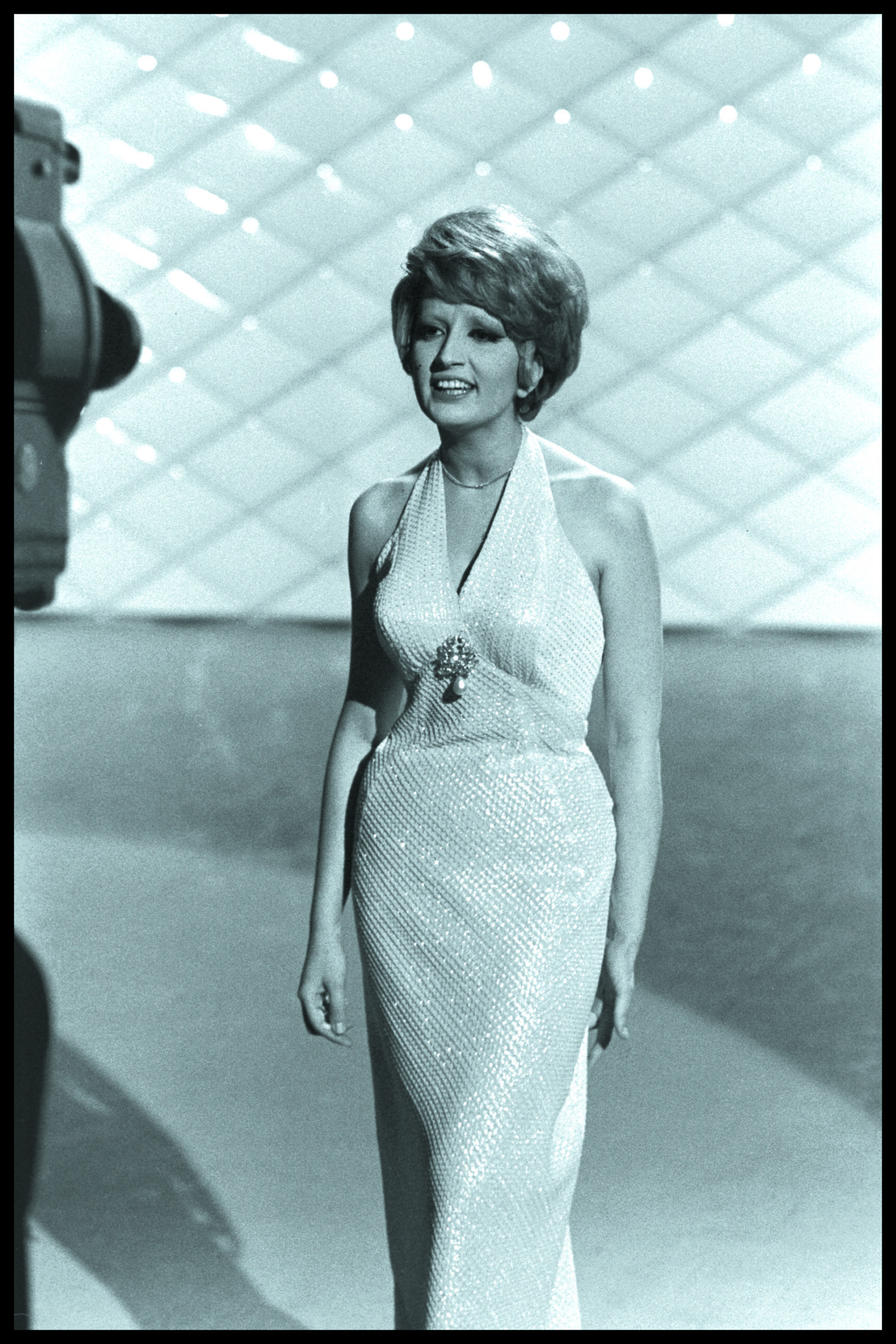
Mina on Studio Uno; photo courtesy of RAI
The Golden Goddess: Alberto Caroli’s “Magic Dress” (1971)
With her wildly experimental artistic spirit that extended to her fashion choices, dressing Mina was a designer’s dream. Although often mistaken for a creation by fashion designer Paco Rabanne, this “Magic Dress” made from hand-beaten gold aluminum squares, Salvitici explains, was created for the singer by Milan-based designer Alberto Caroli. He pioneered and patented this type of “easily modifiable” dress in the early ‘70s, which inspired women to create their own style by adjusting it according to their imagination. While it was a maxi style with high side splits for this shoot with Roberto Bertolini, Mina also wore a mini version of the dress on stage for one of her live performances. Part disco warrior, part metallic goddess, the garments were a head-turning hit of texture, artistry, and innovation; another Mina appearance that made fashion headlines and made Caroli, the creator, very proud indeed.
Another of Giorgio Bocca’s reflections comes to mind when we muse upon how Mina ravished in this artisanal extravaganza: “Some already classify her preciously, attributing to her an untouchable, coin-like beauty, a warrior-like, Amazon-like, Bradamante-like femininity.”
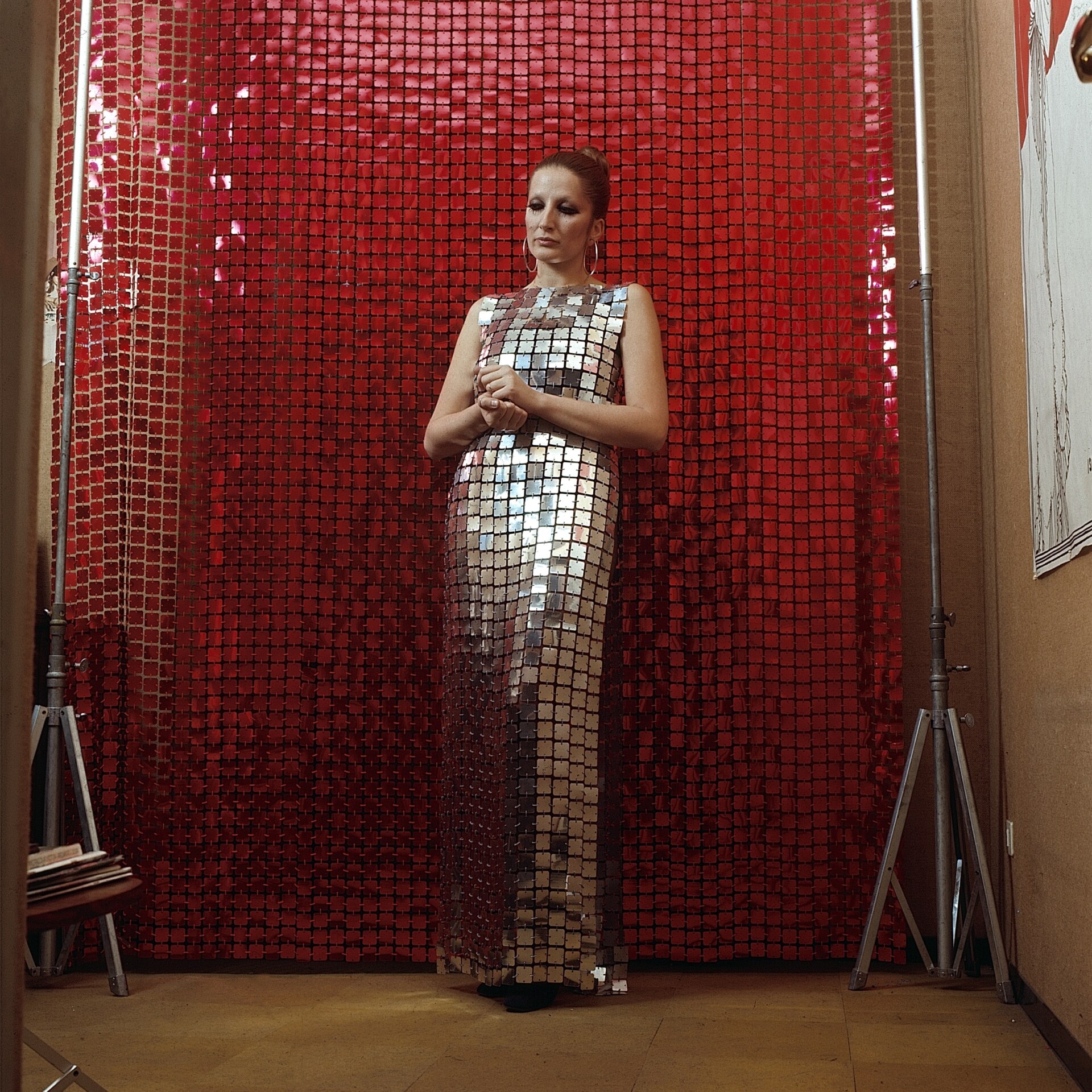
Mina as a metallic goddess in Alberto Caroli’s “Magic Dress”; photo by Roberto Bertolini ©PDU
Mina “off duty”: Street style in the 1960s and ‘70s
What was Mina doing between performing for hysterical audiences across Italy, shooting music videos and TV commercials, and recording album after album in the studio? Being a mother, being a woman, being an Italian. Her off duty style was authentically hers; she favored everything from classic ‘60s shift dresses to casualwear like blue jeans, white shirts, and oversized sunglasses. Despite her mega-star status, Mina’s own sense of style was not outlandish or excessive, but rather, intuitive and authentic. When seen around town, her clothing revealed the essence of what we understand as the “real Mina”; a woman who was by no means a conventional female of her time, and always retained an air of mystery. This only fueled the media and the public’s obsession with her.
“Mina, as they know her, as millions of young people have built her up, is in essence a healthy tortellini eater who pretends, at times, to be a bit of beatnik, a bit of a joke youth. All she has to do is put on a pair of blue-jeans and mess up her hair. Nothing more is asked of her inner torment. Then she can ride around in a white spider, earn millions and dress up by the finest seamstresses,” wrote Bocca.
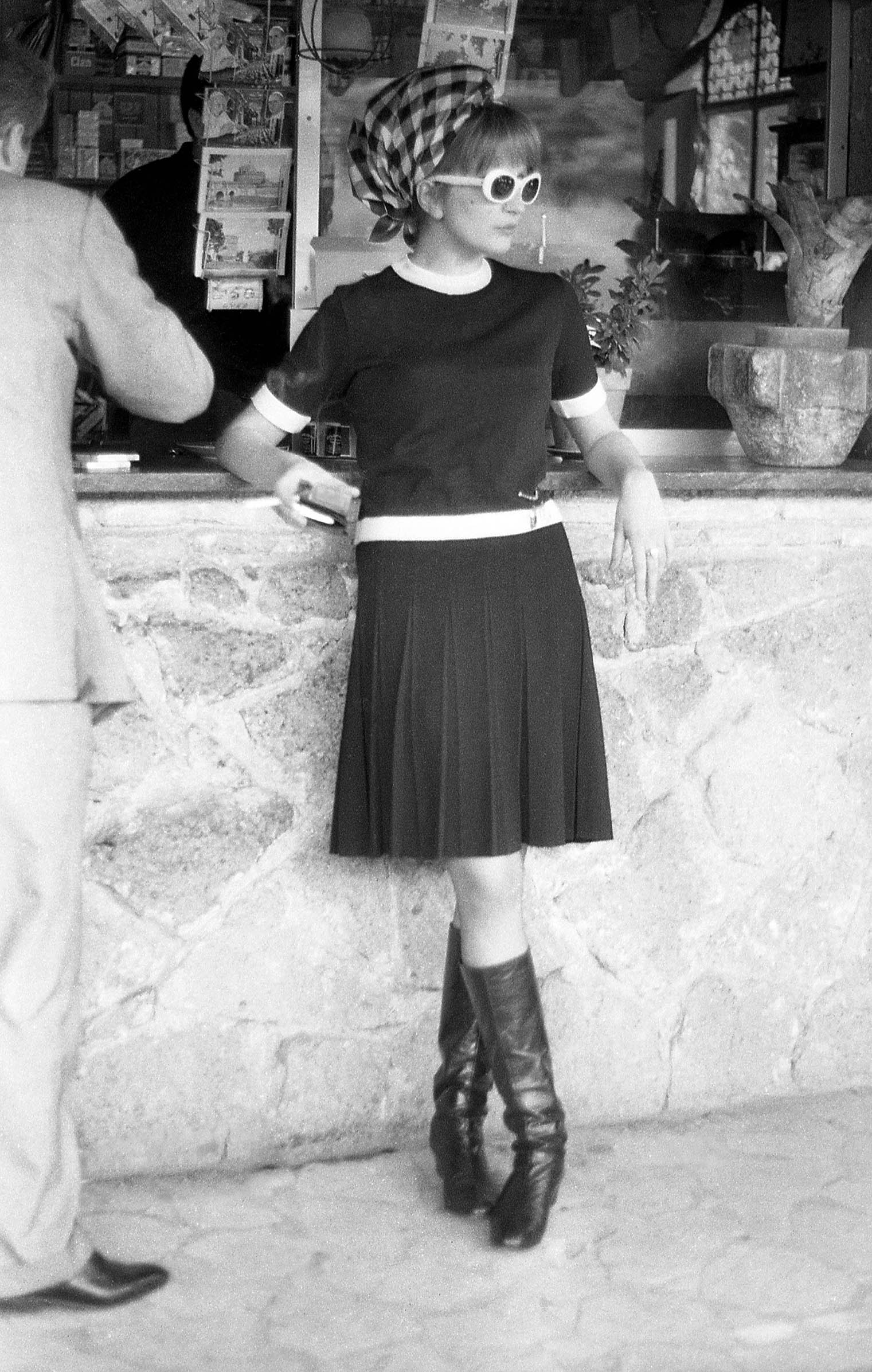
Mina off duty; photo ©MGMC
Wrapped in furs: A matter of warmth in the 1960s and ‘70s
The star loved her fur. When journalists, photographers, and social commentators of the ‘60s and ‘70s depicted Mina, her fur coats often featured. Whether a long-line mink or a dense chinchilla, a fur-trimmed cape or a chic pillbox hat, fur was a defining aspect of Mina’s style signature. In 1969, the singer was photographed for Vogue Italia by Gian Paolo Barbieri, styled in a series of decadent couture ensembles as a star at the height of her glory. Captured in Barbieri’s signature black-and-white film noir style, Mina is adorned in a dramatic fur cape that cascades to the floor around her feet. She is the epitome of cinematic Italian glamor. But, as Fallaci pointed out, the furs Mina wore day to day–whether smoking a cigarette on the street, waiting backstage after a performance, or on her way to dinner–were not deliberate statements of fame or wealth. Rather, they were a matter of practicality, as they were for many Italian women of the time:
“She wears fur not as one who wears fur to show that she owns it but because fur serves as a shelter from the cold, and last week, I am told, she wanted to buy chinchilla, but it was enough for her father to say two little words in her ear for her to reply, ‘That’s okay,’ and make nothing of it,” Fallaci wrote.
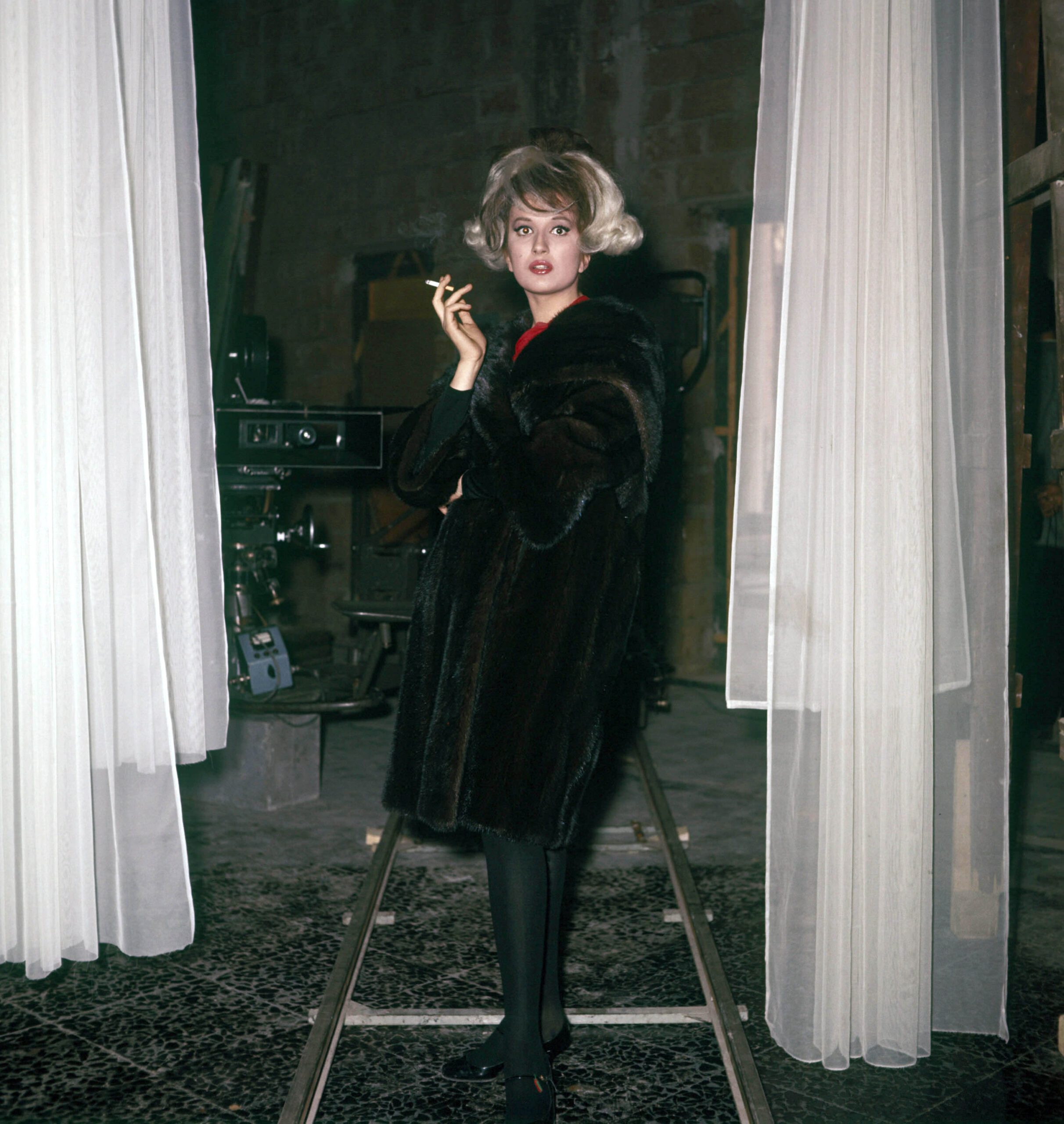
Mina rocking a fur at the end of the '50s in the province of Milan; Photo by PHOTOMASI
The Tigress of Cremona: Versace Silk Cloak (1996)
The drama of it all! Photographer and artist Mauro Balletti captured Mina’s many guises over the decades they worked together, and continue to do so. Through Balletti’s lens, Mina transformed from Sanremo’s sweetheart to feather-clad femme fatale to the avant-garde heroine in what seemed like the blink of an eye. In the late ‘90s, Balletti shot Mina in Cremona for the cover of her album that shares the name with this northern Italian town where she grew up. Posed in the town’s main square, Piazza del Comune, wearing a luscious red operatic dress and cloak exclusively designed by Gianni Versace, Mina is the statuesque embodiment of her unofficial title “The Tigress of Cremona.” This outfit, which Stefano Salvatici says took Versace around three months to create, celebrates how the worlds of theater, history, and art all combined to evoke an ever-present sense of drama in both her music and public persona.
Outfits like these also remind us that Mina maintained her status as Italy’s leading lady in the music and entertainment industries over the decades, as well as being an enduring muse for fashion and couture designers like Versace. Whether live on stage, on TV, or behind the camera, her presence would only become more commanding and captivating as she matured as a woman and an artist.
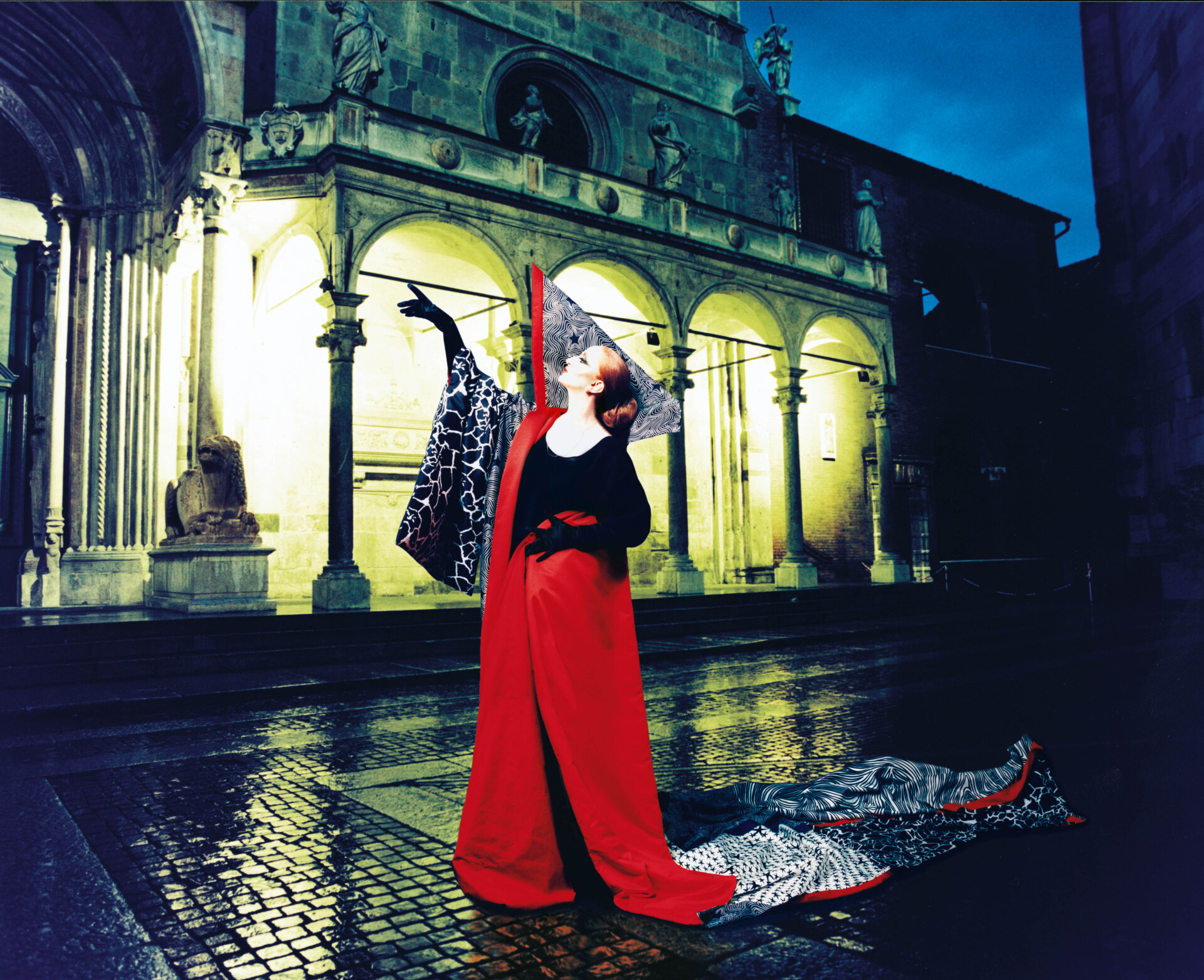
Mina in Versace for the Cremona cover (1996); photo by Mauro Balletti ©PDU
The enigma of gender: Sulla tua bocca lo dirò (2009)
Mina provoked the conventions of gender-based dressing with reckless abandon. She embraced the idea of blurring the boundaries between masculine and feminine, and in doing so, defied conventional stereotypes in Italian and global society. As early as the ‘60s she appeared in masculine sartorial cuts and strong silhouettes, and continued to explore masculine dressing as a source of creative escapism through the subsequent decades.
One of several iconic editorial-style images captured by Mauro Balletti, the inside album image of Sulla tua bocca lo dirò (2009) depicts Mina in a long-line tailored black jacket, open-collared shirt (curiously unbuttoned), and high-black riding boots. With a vacant gaze and a cool, detached stance, there is as much psychology behind this outfit as there is artistry behind the image itself. Mina resembles a figure in a slick 1920s Lolita Lempicka portrait–imposing, modern, and timeless in the same glance. As she had done several times before, the singer jolted Italian society with this stirring vision of “power dressing” that turned social, cultural, and artistic norms on their head.
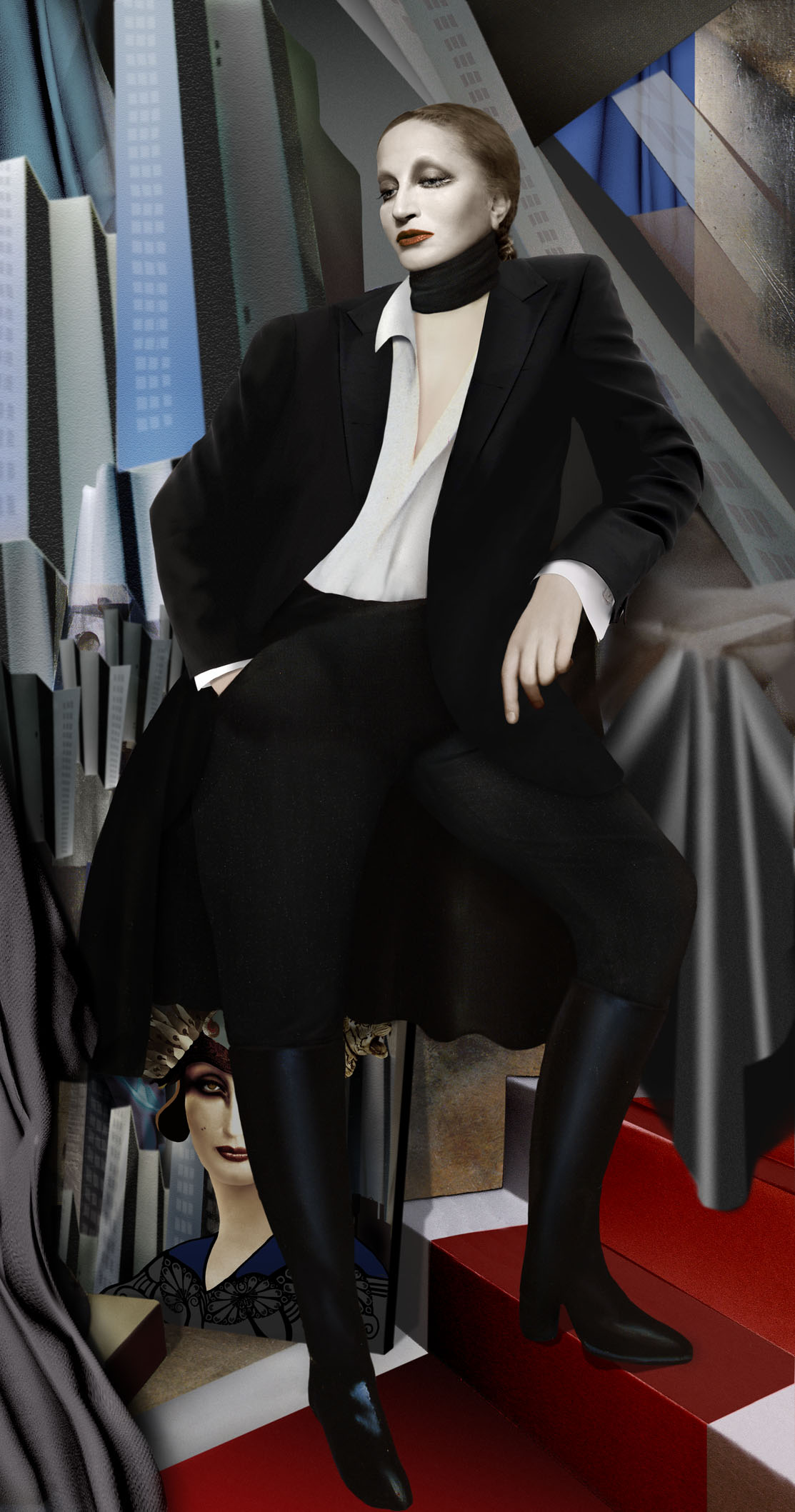
Mina for Sulla tua bocca lo dirò (2009); photo by Mauro Balletti ©PDU
Feathers, furs, or frocks… there’s a bit of Mina in each of us. The star’s most legendary outfits were a thrilling hit of escapism, revealing a defiant disregard for conventional ideas about fashion and style. Each a performance in itself, they were portals to the many Minas that would thrill us, seduce us, and send our hearts a-flutter before she even uttered a single note.
